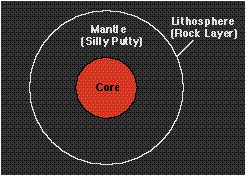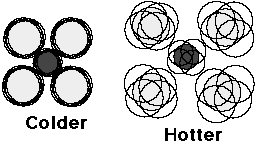
"Why?, what do you mean Why? The story is over. That's the end of it. I promised to tell you about the Blue Whale and I did," pleaded the narrator. "So please, no more questions."
"Hey," said the curious kid, "you can't leave me like
this, without the fiinal answer. Tell me how Antarctica got to the South
Pole."
"Okay, Okay. I'll make it short, and you will need to know about two more of nature's laws. Grab that piece of chalk, go to the chalkboard, and draw a circle the size of a basketball.
OK. Now draw another circle around the first one, almost as big as the chalkboard.

The big circle is the earth, the small circe is the earth's liquid core.
At the earth's surface we think that the earth is hard and breakable, like
a rock. But the hard, rock layer, which includes continents like Antarctica,
is only as thick and the chalk line you just drew. Between the rock layer
(lithosphere) and the core, the earth is made of stuff that slowly flows
and oozes around. When something makes the inside move, it moves like silly
putty. Now we need to put together two laws of nature which are powerful
enough to move the rock layer and a continent.

The first law is about heat. To explain heat we need some jiggling
atoms. Almost everything is made of atoms, and you need a general idea of
what atoms looks like when they are jiggling close together and farther
apart.
Previous Page.......................Next Page